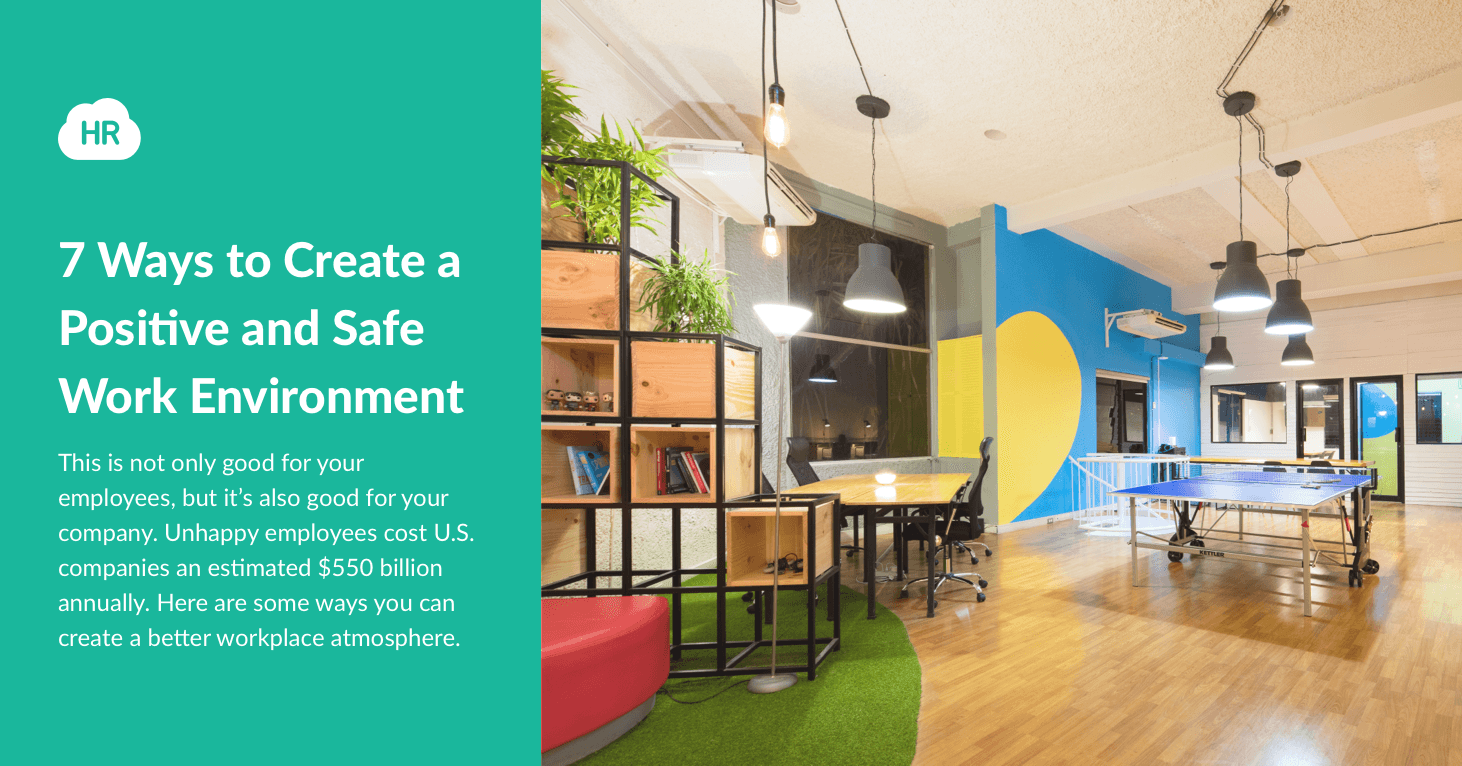

 Cut onboarding time
by 60%—here's the
Ultimate Checklist
that helped do it.
Cut onboarding time
by 60%—here's the
Ultimate Checklist
that helped do it.

It is a basic human need to be in a healthy, safe, and comfortable environment. People spend a decent amount of their time at work, sometimes more than they spend at their own homes, so having a workplace that is positive and safe is important to keep employees healthy, engaged, and productive.
This is not only good for your employees, but it’s also good for your company. Unhappy employees cost U.S. companies an estimated $550 billion annually. Here are some ways you can create a better workplace atmosphere.
1. Provide proper onboarding and training
Not providing new hires with a proper onboarding experience can have an immediate effect on their morale, confidence, productivity, and the way they view your business. First impressions are important when meeting new people, and they are just as important for new employees when entering a workplace. Here are some strategies you can use to improve the onboarding process.
-
Make sure your new hires are properly introduced to their team and to the company's culture.
-
Provide them with ongoing, individualized training with adequate time to learn and practice their skills.
-
Set expectations and goals specifically for your new hire’s role, with clearly defined success metrics and milestones, and communicate with them about opportunities for growth.
-
Make sure their workspace and technology is functioning, clean, and ready for them to get started.
If you are onboarding for a remote team, these onboarding tips can help make the process run smoothly.
2. Be committed as a leader
As a leader, you set the tone for the workplace. People want to be proud of not only where they work but also who they work for. Being committed to your team and to their personal and professional development can have a huge effect on your team's wellbeing, increasing productivity and reducing employee turnover.

To learn even more about improving the employee experience and increasing your competitive advantage while providing a fast return on investment, download our ebook now.
Download now
3. Develop a safe environment
Working in an unsafe environment can have a huge impact on employees' mental and physical wellbeing. It can cause them to have increased levels of stress inside and outside of work, lowered productivity and engagement, increased chances of workplace errors or accidents, and increased absenteeism and turnover.
Here are some signs and behaviors that may be present in an unsafe work environment.
Sexual Harassment
Sexual harassment can take the form of repeatedly asking for dates after the person has said no, sexually explicit talk, unwanted physical touch, aggressive staring or leering, and even requests for sexual favors.
This study found that up to 38% of women experience sexual harassment in the workplace. Make sure you keep up with sexual harassment training requirements based on your state to help prevent and deal with these situations as they arise.
Racial Harassment
Racial harassment may be difficult to identify in the workplace. It can take the form of mocking a fellow team member's accent, using racial slurs or generalizations and telling derogatory jokes.
If someone on your team is experiencing this type of treatment, they may be hesitant to bring it up for fear of it affecting their reputation, job security, or even their personal safety. Incorporating an anonymous system for whistleblowing can be a useful tool for your team to bring up concerns so these issues can be dealt with immediately to prevent legal repercussions.
Sexual Orientation or Gender Identity Harassment
Sexual orientation or gender identity harassment involves offensive, derogatory, or demeaning comments based on a team member’s sexual orientation or gender identity, including a team member’s transgender status. Team members refusing to use the correct pronouns for their fellow team members or using a name that was assigned at birth and they no longer use are included as harassment and should not be tolerated.
Personal Harassment
Personal harassment is a type of harassment that is not part of a protected class, like gender, religion, or race. It is a type of bullying that can most likely be found in toxic work environments. Here are some ways it can be presented:
-
Verbal harassment includes gossip, mockery, offensive jokes, or insults.
-
Intimidation tactics in the form of threats, invasion of privacy, social exclusion, and spying.
-
Work-related practices like giving wrongful blame, sabotaging or interfering with projects, or stealing and taking credit for ideas.
-
Rationalizing or defending bullying, making excuses for acting inappropriately, and blaming the victim for being mistreated.
Personal harassment is often psychological or verbal and not physical, making it harder for others to notice or to act. It is important to listen to team members bringing up concerns on how they or a fellow team member are being treated and to learn tips on how to manage and resolve conflict in the workplace.
-
Disability harassment is when a team member is treated poorly or unfairly in the workplace due to a physical or mental disability. This can include team members using slurs, making inappropriate comments or jokes, and excluding them from work-related functions. In a study by the EEOC, 32.2% of workplace discrimination cases filed in 2018 were for disability harassment, which is only a tenth of a percent behind sexual harassment cases.
4. Hold everyone accountable
It is important that your team knows what is expected of them with their performance and behavior. Without clearly set boundaries and objectives, you can’t expect them to give the results you need. Newly hired employees should be given a grace period, but after that time ends, they should be held fully accountable for their performance.
Your team should all be treated as equals and given an equal amount of work. If you notice an employee not meeting expectations in their competency or behavior, try not to shift their workload onto a better-performing employee. This can put your top performers at an increased risk of burnout, while the underperforming employees’ growth will remain stagnant.
5. Let everyone have a voice
Checking in with your team regularly is important to gather feedback and see where things might need some tweaking in your company. Both one-on-one and group meetings can be useful tools in keeping communication going. Act on the feedback you get and keep your team involved in the process, and when an idea is utilized let the whole team know who came up with the idea.
When members of your team have ideas that are not utilized, open up a conversation with the team member and let them know that you value their input and walk them through why their idea was not chosen, but still encourage them to share their ideas next time.
6. Trust your team
As a leader, your leadership style greatly affects your workplace environment. Leaders who micromanage create a hostile, unsafe work environment that lowers morale, increases stress, reduces productivity, and leads to poor employee retention.
As a leader, you should provide support and guidance, and create a healthy space for your team to freely think act, and perform their best without fear of their actions being perceived as the wrong move. Your team was chosen for a reason, so let them show you what they are capable of and offer guidance when it is truly needed.
Your team works hard. It is important to show your appreciation and say thank you for a job well done in a fair and equal way by avoiding these mistakes when recognizing your team. This will help keep your team motivated and productive, boost their morale, and provide them with a sense of security.
Author Bio: This article is written by our marketing team at HR Cloud. HR Cloud is a leading provider of HR solutions, including recruiting, onboarding, employee engagement, and intranet software. Our aim is to help your company improve employee engagement, employee productivity, and to save you valuable time!
Keep Reading
The Hidden Metrics of Frontline Success: Beyond Engagement Scores
"What gets measured gets managed, but what gets measured well gets transformed." — Peter
Embracing Diversity: Recognizing Different Cultures in the Workplace
Workplaces today reflect the incredible diversity of the world around us. People bring
From Manual to Automated: A Complete Guide to Digitizing Employee Onboarding for Large Organizations
Sarah Chen, Director of HR at a 7,000-employee healthcare organization, starts her Monday
Like What You Hear?
We'd love to chat with you more about how HR Cloud® can support your business's HR needs. Book Your Free Demo

Build a Culture of Recognition. Boost Engagement. Guaranteed.
Workmates empowers employees to stay informed, connected, and appreciated—whether they’re on the front line, in the office, or remote. Recognition drives 12x higher engagement.Trusted by industry leaders in every sector




Cut Onboarding Costs by 60%.
Take the confusion and follow-ups out of onboarding with automated workflows, digital forms, and structured portals—so new hires ramp faster 3X quicker.Trusted by industry leaders in every sector





